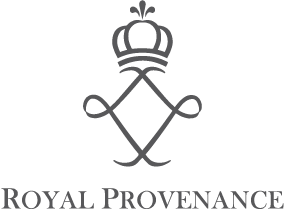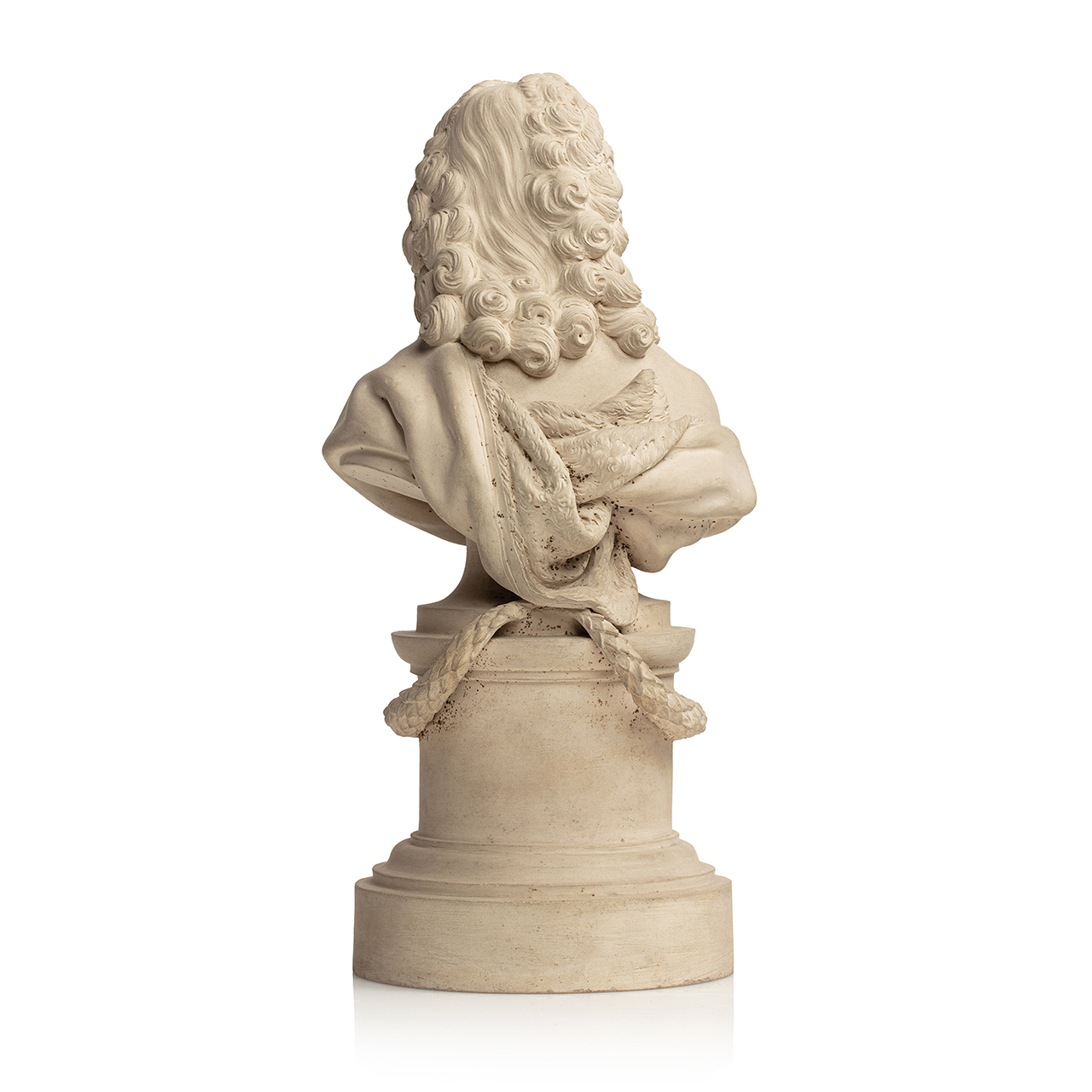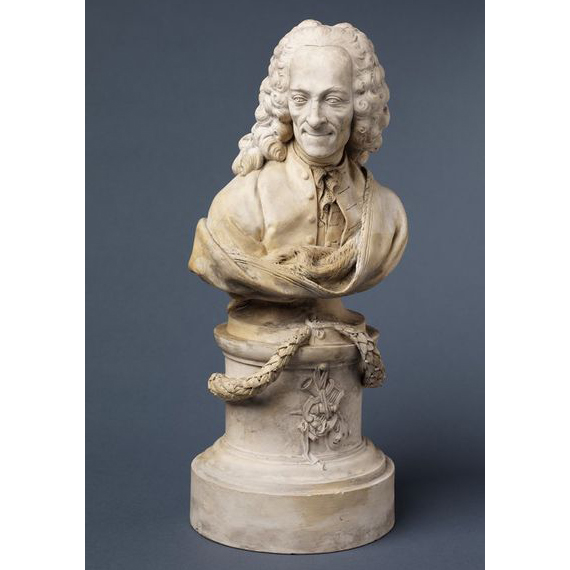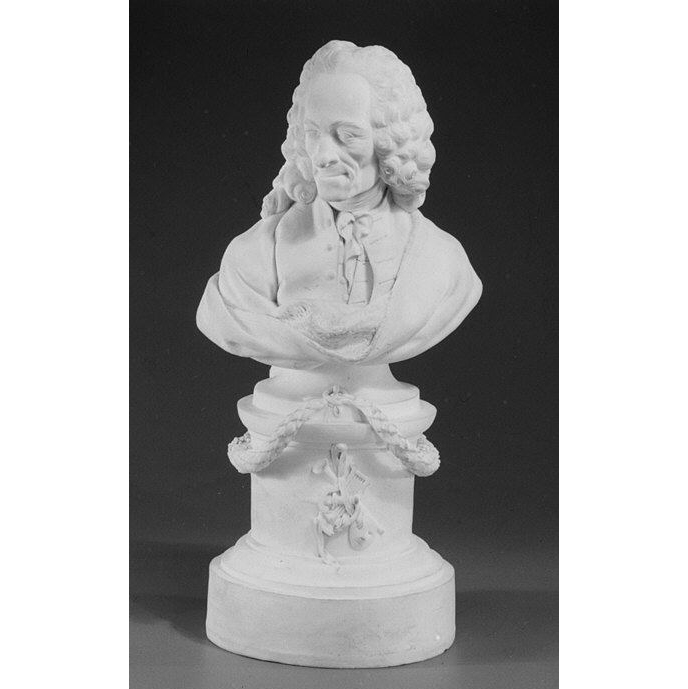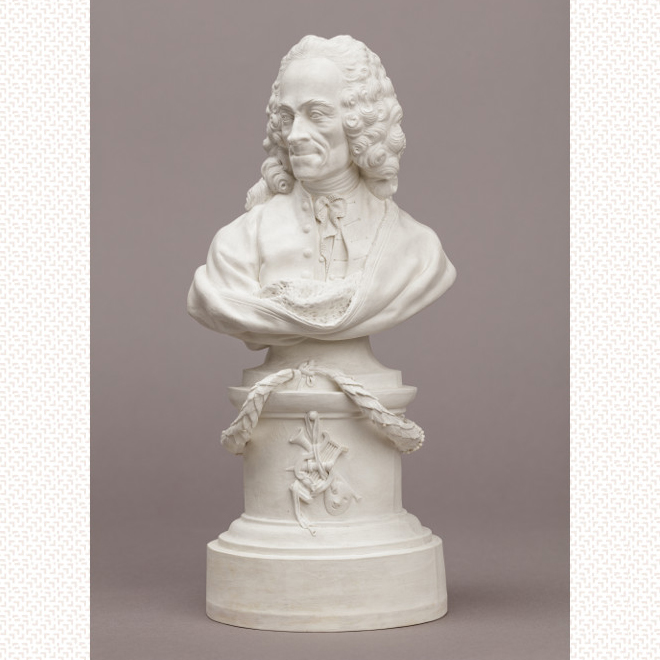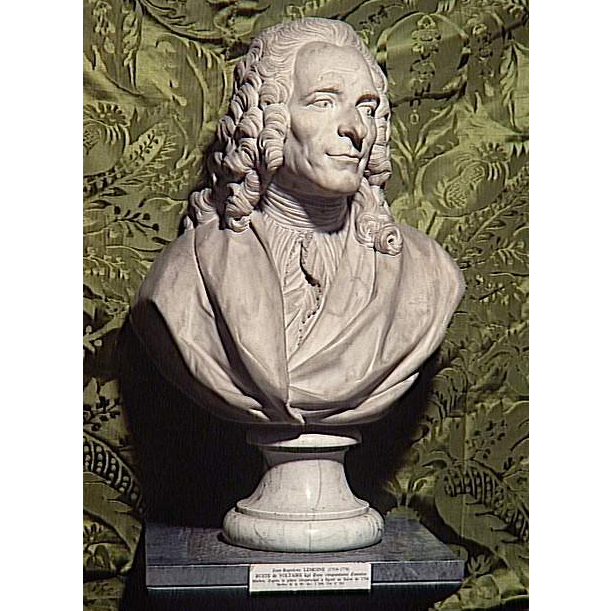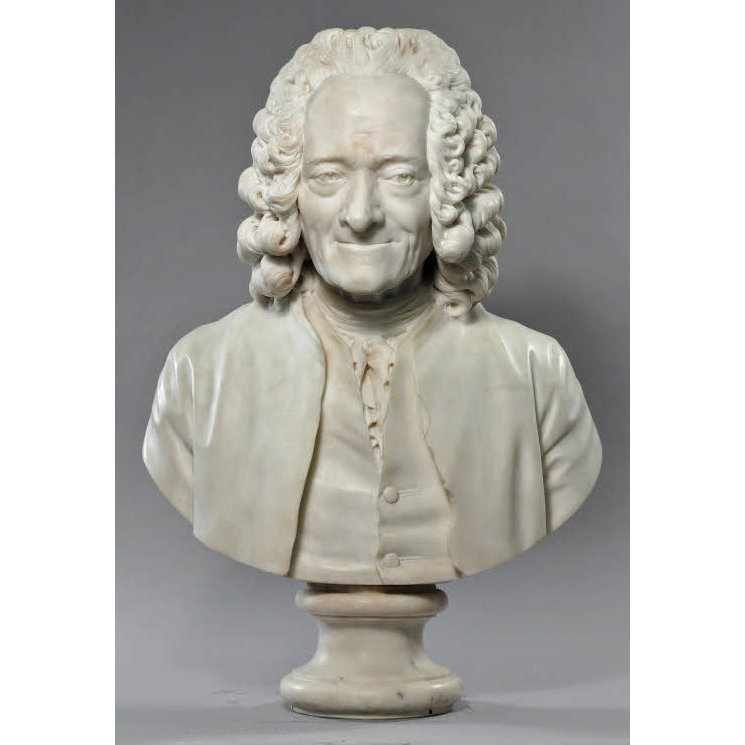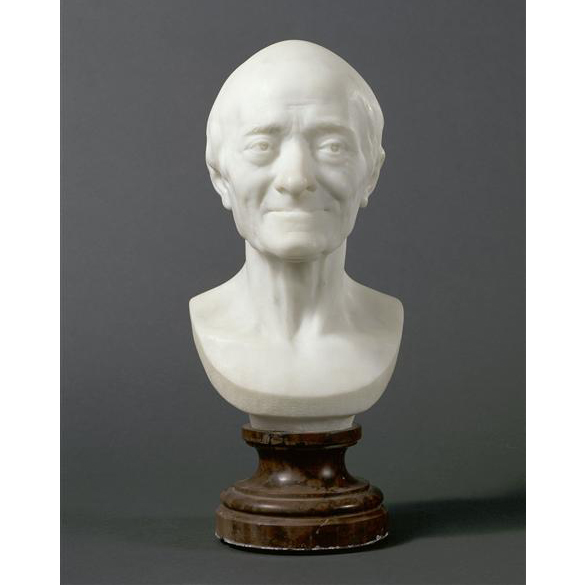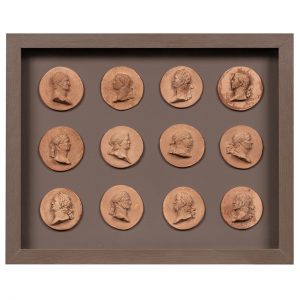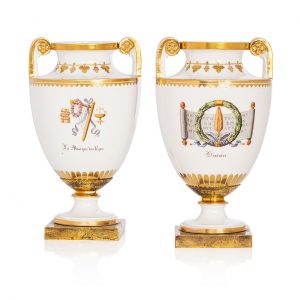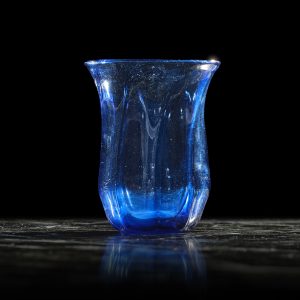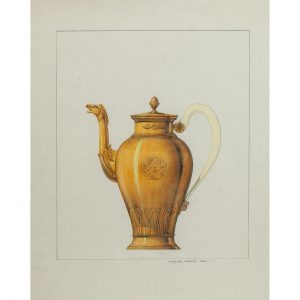Earthenware, close to the "Terre de Lorraine".
François-Marie Arouet said Voltaire (1694-1778) is shown with his head turned slightly to his right, wearing a long curly wig, a lace frilled shirt and an unbuttoned jacket under which we can see a waistcoat. Her shoulders are covered with a coat whose folds reveal the fur. The elongated face and the hollow features of an old man contrast with the bulging forehead, the lively gaze and the tight lips sketching a mocking smile that reflect the intelligence and mischief of the character. The base of the pedestal receives two large garlands of laurels in high relief. It rests on a circular half-column base, without the applique trophy symbolizing the Arts that are usually found on the model.
Slight chips on the base.
Hastière-Lavaux (County of Namur, Belgium), 18th century, dated 1786.
Marked on the reverse: "Hastiere 1786".
H. 28.5 cm.
- A bust in terre de Lorraine, identical but decorated with an applied Arts trophy, with the stamp "Cyfflé à Lunéville" (1767-1779), is kept at the Victoria & Albert Museum in London (inv. C.685-1909) (ill. 4).
- A bust in terre de Lorraine (h. 24.8 cm), identical but decorated with an applied Arts trophy, with the stamp "Terre de Lorraine" (1767-1779), is kept at the Metropolitan Museum in New York ( inv. 68.82) (ill. 5).
- A biscuit hybrid porcelain bust (h. 22.5 cm), identical but decorated with an applied Arts trophy, without stamp but with incised initials (1767-1779), is kept at the Lorraine Museum in Nancy (inv. 95.875) (ill. 6).
- A bust in terre de Lorraine (h. 28 cm), identical but decorated with an applied Arts trophy, with the stamp "Cyfflé à Lunéville" (1767-1779), sold at Crait & Muller, Drouot, July 7, 2017, lot 311, for € 3,024.
Of Bruges origin, Paul-Louis Cyfflé came to settle in the ducal court of Lorraine between 1745 and 1748, as a pupil of the “ordinary sculptor and architect of the king” Barthélémy Guibal (1699-1757), whom he would assist in particular for the statue of King Louis XV on the current Place Stanislas (former Place Royal) in Nancy. On the death of his master, he was appointed official sculptor of Duke Stanislas in 1757. Cyfflé obtained in 1768 a privilege from King Louis XV to found his own factory in Lunéville, for the production of fine earthenware with very white paste called "terre de Lorraine" or "terre de pipe". In 1777, he left the factory which ceased its activity in 1779. After returning to Brussels then to Bruges, punctuated by failures, he established a workshop in 1783 in Hastière-Lavaux, with his wife and his youngest son Louis, without real success. Revolutionary times were not conducive to the type of production Cyfflé wanted. He will end his life in Ixelles from 1791.
François-Marie Arouet, known as Voltaire (1694-1778), stayed several times at the court of Lorraine. After the scandal of the publication of Philosophical Letters, in 1734, he left Paris and took refuge in the castle of Cirey (Haute-Marne), with his friend and mistress Émilie de Breteuil, marquise du Châtelet (1706-1749). In 1735, the philosopher went for the first time alone to Lunéville, to the court of Leopold I, then returned there in 1748 with Émilie du Châtelet. It was during this trip that Cyfflé produced the model of our bust.
At the court of Duke Stanislas Leszczynski, Voltaire met many enlightened spirits, gathered around the Marquise de Boufflers, including the poet François-Antoine Devaux dit Panpan (1712-1796) or even Jean-François, Marquis de Saint-Lambert (1716 -1803) who becomes the new lover of the Marquise du Châtelet. On September 10, 1749, the latter died of childbirth. Very affected, he left Lunéville for good that same year.
Many sculptors have immortalized the features of Voltaire including Jean-Baptiste II Lemoyne (1704-1778), author of a marble bust kept at the royal abbey of Chaalis (ill. 7), or Jean-Antoine Houdon (1741- 1828), who produced two bust models, one in contemporary dress and wig (ill. 8), the other with a truncated torso, bare head, in the manner of the ancient philosophers (Musée du Louvre, inv. RF3520, ill. 9). If Houdon obtained a few posing sessions in Paris in 1778, it is not certain that Paul-Louis Cyfflé, then a student of Barthélémy Guibal during Voltaire's second stay in Lunéville in 1748, had this privilege. However, he was able to meet the philosopher on this occasion. Cyfflé's work has been so successful that it has been reproduced and widely distributed.
- Maurice NOËL, « Recherches sur la céramique lorraine au XVIIIe siècle », thèse non publiée, Université de Nancy, 1961, p. 183.
- Maurice NOËL, « Les biscuits de Cyfflé, étude de thèmes », La Lorraine dans l’Europe des Lumières, Actes du colloque de la Faculté des lettres et des sciences humaines de l’Université de Nancy, 1968, p. 183.
- Maurice NOËL, « Les acquéreurs de statuettes en terre de Lorraine », Le Pays lorrain, Nancy, 1998, p. 39.
- Maïté HORIOT, Paul-Louis Cyfflé et les terres de Lorraine aux XVIIIe-XIXe siècles dans les collections du Musée Historique Lorrain, mémoire de maîtrise d’histoire de l’art sous la direction de François PUPIL et Francine ROZE, Université de Nancy 2, 2002-2003, pp. 175-176, n°84.
- Catherine CALAME, Cyfflé, orfèvre de l’argile. Ses statuettes en terre de Lorraine et les reprises par les manufactures régionales [cat. exp., « Cyfflé, orfèvre de l’argile », Saint-Clément, 1er août-17 août 2009], Lunéville, Association des Amis de la Faïence ancienne de Lunéville Saint-Clément, Office de Tourisme et château des Lumières, 2009, pp. 12, 13, 95, 96, 177.
- Catherine CALAME et Marino MAGGETTI, « Paul-Louis Cyfflé et ses recettes de Terre de Lorraine », Revue de la société des amis du Musée national de la céramique, n°21, 2012, p.74-86.
- Marino MAGGETTI, « La « Terre de Lorraine » de Paul Louis Cyfflé (1724-1806) », En passant par la Lorraine, Keramik-Freunde des Schweiz, n° 126, 2012, p.91-94.
- Frédéric THOMAES et Andries VAN DEN ABEELE, « Paul Louis Cyfflé (1724-1806), un Brugeois en Lorraine », Le Parchemin, mars-avril 2008, p. 82-128.
